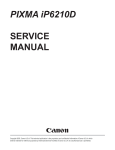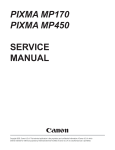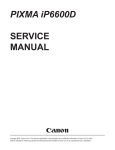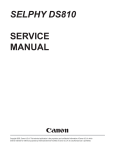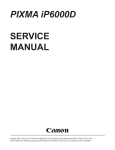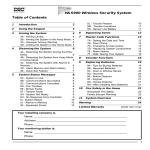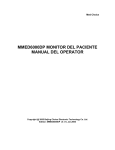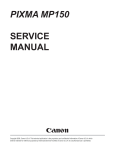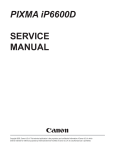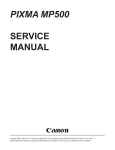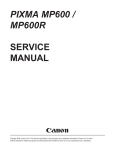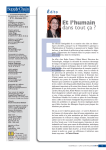Download Canon iP6220D - PIXMA Color Inkjet Printer Service manual
Transcript
PIXMA iP6220D SERVICE MANUAL Canon Copyright 2005, Canon U.S.A. This technical publication is the proprietary and confidential information of Canon U.S.A. which shall be retained for reference purposes by Authorized Service Facilities of Canon U.S.A. Its unauthorized use is prohibited. Scope This manual has been issued by Canon Inc., to provide the service technicians of this product with the information necessary for qualified persons to learn technical theory, installation, maintenance, and repair of products. The manual covers information applicable in all regions where the product is sold. For this reason, it may contain information that is not applicable to your region. Revision This manual could include technical inaccuracies or typographical errors due to improvements or changes made to the product. When changes are made to the contents of the manual, Canon will release technical information when necessary. When substantial changes are made to the contents of the manual, Canon will issue a revised edition. The following do not apply if they do not conform to the laws and regulations of the region where the manual or product is used: Trademarks Product and brand names appearing in this manual are registered trademarks or trademarks of the respective holders. Copyright All rights reserved. No parts of this manual may be reproduced in any form or by any means or translated into another language without the written permission of Canon Inc., except in the case of internal business use. Copyright © 2005 by Canon Inc. CANON INC. Inkjet Device Quality Assurance Div. 1 451, Tsukagoshi 3-chome, Saiwai-ku, Kawasaki-shi, Kanagawa 212-8530, Japan I. MANUAL OUTLINE This manual consists of the following three parts to provide information necessary to service the PIXMA iP6220D: Part 1: Maintenance Information on maintenance and troubleshooting of the PIXMA iP6220D Part 2: Technical Reference New technology and technical information such as FAQ's (Frequently Asked Questions) of the PIXMA iP6220D Part 3: Appendix Block diagrams and pin layouts of the PIXMA iP6220D Reference: This manual does not provide sufficient information for disassembly and reassembly procedures. Refer to the graphics in the separate Parts Catalog. II. TABLE OF CONTENTS Part 1: MAINTENANCE 1. MAINTENANCE 1-1. Adjustment, Periodic Maintenance, Periodic Replacement Parts, and Replacement Consumables by Service Engineer 1-2. Customer Maintenance 1-3. Product Life 1-4. Special Tools 1-5. Serial Number Location 2. LIST OF ERROR DISPLAY / INDICATIONS 2-1. Operator Call Errors 2-2. Service Call Errors 2-3. Warnings 2-4. Troubleshooting by Symptom 3. REPAIR 3-1. Notes on Service Part Replacement (and Disassembling / Reassembling) 3-2. Special Notes on Repair Servicing 3-3. Adjustment / Settings (1) Paper feed motor adjustment (2) Main chassis and carriage rail adjustment (3) Grease application (4) Waste ink counter setting (5) User mode (6) Service mode 3-4. Verification Items (1) Service test print (2) EEPROM information print Part 2: TECHNICAL REFERENCE 1. NEW TECHNOLOGIES 2. CLEANING MODE AND AMOUNT OF INK PURGED 3. PRINT MODE 3-1. Resolution in Printing via Computer (Print on One or Both Sides of Paper, Photo and CL Cartridges, Color Mode) 3-2. Resolution in Printing via Computer (Print on One or Both Sides of Paper, CL Cartridge, Color or Monochrome Mode) 3-3. Resolution in Borderless Printing (Print on One or Both Sides of Paper, Photo and CL Cartridges, Color Mode) 3-4. Resolution in Borderless Printing (Print on One or Both Sides of Paper, CL Cartridges, Color or Monochrome Mode) 3-5. Resolution in Direct Printing 4. FAQ (Problems Specific to the iP6220D and Corrective Actions) Part 3: APPENDIX 1. BLOCK DIAGRAM 2. CONNECTOR LOCATION AND PIN LAYOUT 2-1. Main Board 2-2. Operation Panel Board L 2-3. Operation Panel Board R 2-4. Card Slot Board (Card Slot Unit) 2-5. Carriage Board (Print Head Connector) 3. SPECIFICATIONS Part 1 MAINTENANCE 1. MAINTENANCE 1-1. Adjustment, Periodic Maintenance, Periodic Replacement Parts, and Replacement Consumables by Service Engineer (1) Adjustment Adjustment Timing Purpose Tool Approx. time EEPROM initialization (EEPROM settings) At logic board ass'y replacement To initialize settings other than the following: - USB serial number - Destination setting - Waste ink counter None. 1 min. Destination settings (EEPROM settings) At logic board ass'y replacement To set the destination. None. 1 min. LCD language settings At logic board ass'y replacement To set the language to be displayed on the LCD. None. 1 min. Waste ink counter resetting (EEPROM settings) - At bottom case unit replacement - At ink absorber replacement To reset the waste ink counter. None. 1 min. Print head alignment - At printer setup - At print head replacement - At logic board ass'y replacement - At carriage unit replacement To ensure accurate dot placement. - Machine buttons (Auto/Manual) - Computer (settings via the printer driver) (Auto/Manual) Auto:4 min. Manual:3 min. Paper feed motor position adjustment*1 At paper feed motor unit replacement To adjust the belt tension. (Position the paper feed motor so that the belt is stretched tight.) None. 2 min. Grease application - At carriage unit replacement - At bottom case unit replacement - At platen replacement - At eject roller replacement - At cap blade unit replacement - - To maintain sliding properties of the carriage, cap blade unit, and eject rollers. - FLOIL KG107A (QY90057) - MOLYKOTE PG641 (CK0562) 1 min. *1: Red screws of paper feed motor The red screws securing the paper feed motor may be loosened only at replacement of the paper feed motor unit. (2) Periodic maintenance No periodic maintenance is necessary. (3) Periodic replacement parts There are no parts in this machine that require periodic replacement by a service engineer. (4) Replacement consumables There are no consumables that require replacement by a service engineer. 1-1 1-2. Customer Maintenance Adjustment Timing Purpose Tool - Machine buttons (Auto/Manual) - Computer (settings via the printer driver) (Auto/Manual) Approx. time Print head alignment When print quality is not satisfying. When printer is set up. To ensure accurate dot placement. Print head cleaning When print quality is not satisfying. To improve nozzle conditions. - Machine button - Computer (settings via the MP driver) 1 min. Print head deep cleaning When print quality is not satisfying, and not improved by print head cleaning. To improve nozzle conditions. - Machine button - Computer (settings via the MP driver) 2 min. Ink cartridge replacement When an ink cartridge becomes empty. (No ink error) ----- ----- Auto:4 min. Manual:3 min. 2 min. Paper feed roller When paper does not feed properly. cleaning To clean the paper feed rollers. Machine button 2 min. Bottom plate cleaning To clean the platen ribs. - Machine button - Computer (settings via the MP driver) 1 min. When the back side of the paper is smeared 1-3. Product Life (1) Machine Specified print volume (I) or the years of use (II), whichever comes first. (I) Print volume 6,600 pages Black 1,500 character pattern 1,300 pages Color A4, 7.5% duty per color pattern 1,000 pages A4, 30 % duty per color pattern 1,000 pages 4 x 6, 30 % duty per color pattern 3,000pages Postcard, 30 % duty per color pattern 300 pages (II) Years of use 5 years of use (2) Ink cartridge (ink tank with nozzles) (target value) CL-52: 450 pages 710 pages (1,500 character pattern / plain paper / standard mode) (ISO JIS-SCID No. 5 / plain paper / standard mode) CL-51: 330 pages (ISO JIS-SCID No. 5 / plain paper / standard mode) CL-52: 110 pages (24 photos taken by a digital camera / borderless printing / SP101 4x6 / standard mode) CL-51: 180 pages (24 photos taken by a digital camera / borderless printing / SP101 4x6 / standard mode) 1-2 1-4. Special Tools Name Tool No. Application Remarks MOLYKOTE PG-641 QY9-0035-000 To be applied to the chassis. In common with other models. FLOIL KG-107A QY9-0057-000 To be applied to the sliding portion of the carriage, and the platen link. In common with other models. 1-5. Serial Number Location On the chassis (visible when the front cover is open). To the table of contents To the top <Part 1: 1.MAINTENANCE> 1-3 2. LIST OF ERROR DISPLAY / INDICATIONS Errors and warnings are displayed by the following ways: 1) Operator call errors are indicated by the Alarm LED lit. (In the service mode, the Alarm LED blinks to indicate errors.) Service call errors are indicated by the number of cycles the Alarm and Power LEDs blink. 2) Errors and warnings are displayed on the LCD on the operation panel. 3) Warnings are displayed on the MP driver Status Monitor. 2-1. Operator Call Errors (by Alarm LED Lit in Orange) LCD Message Alarm LED blinking in orange (in the service mode only) Error [Error code] Solution Remarks There is no paper. Load paper and press [OK]. 2 times No paper. (ASF) [1000] Set the paper in the ASF, and press the OK button. The paper is jammed. Clear the paper and press [OK]. 3 times Paper jam. [1300] Remove the jammed paper, and press the OK button. No ink. [1600] Replace the empty ink Pressing the OK button will cartridge(s), or press the exit the error without ink OK button. cartridge replacement, however, ink may run out during printing. Ink has run out. Replace the ink cartridge and close the cover. U041 - The following ink cartridge cannot be recognized. U051 / U059 5 times Ink cartridge not installed. [1401] Ink cartridge not for this model installed. [1485] Confirm that the ink cartridges are for this model, install them properly, then close the front cover. The following ink cartridge cannot be recognized. U052 15 times Ink cartridge not installed. [1682] Re-install the applicable ink cartridge(s) properly, and close the front cover. Or, with the ink cartridges installed, turn the machine off and on again. The following ink cartridge cannot be recognized. U140 - Ink cartridge not for this model installed. [1684] Confirm that the ink cartridges are for this model, install them properly, then close the front cover. Some ink cartridge are not installed in place. U075 7 times Multiple ink cartridges Replace the wrong ink of the same color cartridge with the correct installed. [1687] one. Some ink cartridge are not installed in place. U076 7 times Ink cartridge in a Install the ink cartridge wrong position. [1686] in the correct position. The following ink cartridge cannot be recognized. U053 4 times Improper installation of an ink cartridge. [1687] Re-install the applicable ink cartridge(s) properly, and close the front cover. - Warning: The waste Pressing the OK button The waste ink 1-4 The service call error, absorber is almost full. Press [OK] to continue but early replacement recommended. <See manual> ink absorber becomes almost full. [1700 for the main waste ink absorber, 1710 for the platen waste ink absorber] will clear the error, and indicating the waste ink enable printing. absorber is full, is likely to occur soon. At repair*1: For main waste ink absorber replacement, replace - the bottom case unit, or - the ink absorber kit For platen ink absorber replacement, replace - the ink absorber , and - the ink absorber kit MP450: QY5-0151). Remove the cable between the camera and the machine, press the Stop/Reset button, then re-connect the cable. Incompatible device detected. Remove the device. - The connected digital camera or digital video camera does not support Camera Direct Printing. [2001] The following ink may have run out. U161 An ink cartridge that was once empty is installed. U162 - Remaining ink amount A once-used ink unknown. [1685/1686] cartridge (except the one which has been used until just before replacement) is installed. Replace the applicable ink cartridge with a new one, or press the OK button. Auto head align has failed. Press [OK] and repeat operation. <See manual> - Failed in automatic print head alignment. Press the OK button to Press the Stop/Reset button. exit the error, confirm - If paper is being fed at the following, then do error occurrence, the error the print head alignment is indicated after the paper again: is ejected. - If the error occurs, the print - Set A4 or LTR size head alignment values are plain paper. not changed. - If the ink nozzles are After exit from the error by clogged, cleaning the the Stop/Reset button, the ink cartridge. automatic print head - If the paper output slot alignment will not be rehas been exposed to a done. strong light, move the printer to a darker location. Cover is open. - Front cover open. [1200] Close the front cover. Pressing the OK button will exit the error without ink cartridge replacement, however, the function to detect the remaining ink amount is disabled. *1: The main waste ink absorber is separate from the platen waste ink absorber. In servicing, replace the waste ink absorber which becomes full. [See Section 3-3. Adjustment / Settings, (6) Service mode, for details.] 1-5 2-2. Service Call Errors (by Cyclic Blinking in Orange (Alarm LED) and Green (Power LED), or Alarm LED Lit in Orange) Cycles of blinking in orange (Alarm LED) and green (Power LED) Error [Error code] Solution (Replacement of listed parts, which are likely to be faulty) 2 times Carriage error [5100] - Carriage unit (QM2-3332) - Timing slit strip film (QC1-6015) - Logic board ass'y (QM2-2840)*1 - Carriage motor (QM2-2865) 3 times Paper feed error [6000] - Timing sensor ass'y (QM2-2850) - Timing slit disk film (QC1-4962) - Feed roller ass'y (QL2-1284) - Platen (QC1-7503) - Logic board ass'y (QM2-2840)*1 - Paper feed motor (QM2-2866) 4 times Purge unit error [5C00] - Carriage unit (QM2-3332) - Timing slit strip film (QC1-6015) - Logic board ass'y (QM2-2840)*1 - Carriage motor (QM2-2865) 5 times ASF (cam) sensor error [5700] - Drive ass'y (QM2-3333) - PE sensor ass'y (QM2-2855) - Pressure roller ass'y (QM2-3337) 6 times Internal temperature error [5400] - Logic board ass'y (QM2-2840)*1 7 times Waste ink absorber full [5B00]*2 Main waste ink absorber: - Bottom case unit (QM2-3321)*3 - Ink absorber kit (QY5-0148) Platen waste ink absorber: - Ink absorber (QC1-6014) - Ink absorber kit (QY5-0148) 8 times Cartridge temperature rise error [5200] - Print head - Logic board ass'y (QM2-2840)*1 9 times EEPROM error [6800] - Logic board ass'y (QM2-2840)*1 13 times Paper feed position error [6B00] - Paper feed motor (QM2-2866) - Logic board ass'y (QM2-2840)*1 15 times USB Host VBUS overcurrent [9000] - Logic board ass'y (QM2-2840)*1 17 times Motor driver error [6D00] - Logic board ass'y (QM2-2840)*1 20 times Other hardware error [6500] - Logic board ass'y (QM2-2840)*1 Continuous alternate blinking ROM error - Logic board ass'y (QM2-2840)*1 Lights in orange RAM error - Logic board ass'y (QM2-2840)*1 *1: Before replacement of the logic board ass'y, check the waste ink amount, and re-set the waste ink amount value in the replaced logic board. [See Section 3-3. Adjustment / Settings, (6) Service mode, for details.] *2: The main waste ink absorber is separate from the platen waste ink absorber. In servicing, replace the waste ink absorber which becomes full. [See Section 3-3. Adjustment / Settings, (6) Service mode, for details.] *3: Reset the waste ink counter when replacing the bottom case unit. The main and platen waste ink counters can be reset separately. [See Section 3-3. Adjustment / Settings, (6) Service mode, for details.] 1-6 2-3. Warnings Machine (displayed on the LCD): Displayed warning Remarks Low ink Print head temperature rise If the print head temperature is high when the scanning unit is opened, the warning is displayed.*1 When the print head temperature falls, the warning is released. Protection of excess rise of the print head If the print head temperature exceeds the specified limit, a Wait is inserted temperature during printing, *1: If the warning is displayed, the carriage does not move to the ink cartridge replacement position when the scanning unit is opened. 2-4. Troubleshooting by Symptom Symptom Solution The power does not turn on. The power turns off immediately after power-on. Replace the - AC adapter, or Strange noise. Remove foreign material, or attach a removed part if any. Printing stops mid-way. Replace the logic board ass'y*1. Nothing is displayed on the LCD. - Confirm the connection of the LCD, operation panel, and the logic board ass'y. - Replace the - LCD, or - logic board ass'y. A portion of the LCD is not displayed. - Perform the button and LCD test in the service mode, and confirm that the LCD is displayed without any segments missing. - Confirm the connection of the LCD, operation panel, and the logic board ass'y. - Replace the - LCD, or - logic board ass'y. Multiple sheets feed. Replace the - drive unit, or - pressing plate ass'y. Paper does not feed. Remove foreign material, or replace the - drive unit, or - pressing plate ass'y. Paper feeds at an angle. Remove foreign material, or adjust the paper guide, or replace the - drive unit, or - pressing plate ass'y. No printing, or no color ejected. Replace the Faulty operation Paper feed problems - logic board ass'y*1. - ink cartridge*2, - logic board ass'y*1, 1-7 Remarks - drive unit, or - cap blade unit. Printing is faint, or white lines appear Remove and re-install the ink on printouts even after print head cartridges, or replace the cleaning. - ink cartridge*2, Line(s) not included in the print data - cap blade unit, appears on printouts. - purge unit, or - logic board ass'y*1. Unsatisfactory print quality Paper gets smeared. Feed several sheets of paper, perform bottom plate cleaning, or clean the paper path with cotton swab or cloth. A part of a line is missing on printouts. Replace the ink cartridge(s)*2. Color hue is incorrect. Replace the ink cartridge*2, or perform print head alignment. Printing is incorrect. Replace the logic board ass'y*1. No ejection of black ink. Replace the ink cartridge(s)*2. Graphic or text is enlarged on printouts. When enlarged in the carriage movement direction, clean grease or oil off the timing slit strip film, or replace the - timing slit strip film, - carriage unit, or - logic board ass'y*1. When enlarged in the paper feed direction, clean grease or oil off the timing slit disk film, or replace the - timing slit disk film, - timing sensor unit, or - logic board ass'y*1. *1: Before replacement of the logic board ass'y, check the waste ink amount, and re-set the waste ink amount value on the replaced logic board. [See Section 3-3. Adjustment / Settings, (6) Service mode, for details.] *2: Replace the print head only after the print head deep cleaning is performed 2 times, and when the problem persists. To the top To the table of contents <Part 1: 2. LIST OF ERROR DISPLAY / INDICATION> 1-8 3. REPAIR 3-1. Notes on Service Part Replacement (and Disassembling / Reassembling) Service part Logic board ass'y QM2-2840 Bottom case unit QM2-3321 Notes on replacement*1 Adjustment / settings - Before removal of the logic board ass'y, remove the power cord, and allow for approx. 1 minute (for discharge of capacitor's accumulated charges), to prevent damage to the logic board ass'y. - After replacement, reset the waste ink amount data in the replaced logic board ass'y. [See 3-3. Adjustment / Settings, (6) Service mode, for details.] After replacement: 1. Initialize the EEPROM. 2. Set the destination in the EEPROM. 3. Set the LCD language. [See 3-3. Adjustment / Settings, (6) Service mode, for details of 1 to 4.] 4. Perform the print head alignment in the user mode. - EEPROM information print - Service test print - Printing via parallel or USB connection - Direct printing from a digital camera - Direct printing from a memory card Main platen waste ink absorber After replacement: 1. Reset the main waste ink counter. [See 3-3. Adjustment / Settings, (6) Service mode.] 2. Adjust the head-to-paper distance. [See 3-3. Adjustment / Settings, (6) Service mode.] - Service test print - Printing on thick paper Ink absorber QY5-0148 Operation check - Print Beam printing Carriage unit QM2-3332 The red screws on both sides At replacement: - Printing on thick paper of the main chassis securing 1. Apply grease to the sliding the carriage shaft are allowed portions. to be loosened only when [See 3-3. Adjustment / replacing the carriage or Settings, (3) Grease removing the main chassis. application.] Before removing the screws, 2. Adjust the distance between mark the original screw the carriage shaft and the position, and re-fasten them at platen. the original position. [See 3-3. Adjustment / Settings, (2) Main chassis and carriage rail adjustment.] 3. Perform the print head alignment in the user mode. Paper feed motor unit QM2-2866 - The red screws securing the At replacement: paper feed motor are allowed 1. Adjust the paper feed to be loosened. (DO NOT motor. loosen any other red screws.) [See 3-3. Adjustment / Settings, (1) Paper feed motor adjustment.] Timing slit strip film QC1-6015 Timing slit disk film - Upon contact with the film, wipe the film with ethanol. - Confirm no grease is on the film. (Wipe off any grease thoroughly with ethanol.) QC1-4962 - Do not bend the film After replacement: 1. Perform the print head alignment in the user mode. 1-9 - Service test print *1: General notes: - Make sure that the flexible cables and wires in the harness are in the proper position and connected correctly. [See 3-2. Special Notes on Repair Servicing, (1) Flexible cable and harness wiring, connection, for details.] - Do not drop the ferrite core, which may cause damage. - Protect electrical parts from damage due to static electricity. - Before removing a unit, after removing the power cord, allow the machine to sit for approx. 1 minute (for capacitor discharging to protect the logic board ass'y from damages). - Do not touch the timing slit strip film and timing slit disk film. No grease or abrasion is allowed. - Protect the units from becoming soiled with ink. - Protect the housing from scratches. - Exercise caution with the red screws, as follows: i. The red screws of the paper feed motor may be loosened only at replacement of the paper feed motor unit (DO NOT loosen them in other cases). ii. Except for carriage replacement, DO NOT loosen the red screws (which secures the carriage shaft positioning) on both sides of the main chassis. After replacement of the carriage, print on thick paper to confirm that the distance between the carriage shaft and the platen is proper, and there is no contact of the ink cartridges to the paper. If the ink cartridges contact the paper, adjust the carriage shaft, while referring to [3-3. Adjustment / Settings, (2) Main chassis and carriage rail adjustment.] To the table of contents To the top <Part 1: 3. REPAIR, 3-1> 1-10 3-2. Special Notes on Repair Servicing (1) Flexible cable and harness wiring, connection Be careful of wiring of the flexible cables and harness. Improper wiring or connection may cause breakage of a line, leading to ignition or emission of smoke. 1-11 To the table of contents To the top <Part 1: 3. REPAIR, 3-2> 1-12 3-3. Adjustment / Settings (1) Paper feed motor adjustment Perform the following adjustments when the paper feed motor unit is replaced: 1) When removing the screws, mark the screw hole. 2) When installing the motor, position each screw to the mark, and fasten them. 3) After replacement, be sure to perform the service test print, and confirm that no strange noise or faulty print operation (due to dislocation of the belt or gear, or out-of-phase motor, etc.) occurs. Note: The red screws securing the paper feed motor may be loosened only at replacement of the paper feed motor unit. DO NOT loosen them in other cases. (2) Main chassis and carriage rail adjustment [Carriage rail adjustment] Perform the following adjustments when the carriage unit is replaced: 1) Before loosening the red screws, mark the boss position beside the screw. 2) In attaching the carriage rail, make sure that the boss fits into the hole and to the mark made in step 1), then fasten the screws. 3) Be sure to perform the confirmation test detailed below; confirm that the print quality is proper and the ink cartridges are not contacting the paper. 1-13 [Main chassis adjustment] After installing the main chassis, be sure to perform the confirmation test detailed below; confirm that the print quality is proper and the ink cartridges are not contacting the paper. <Confirmation test> Using Photo Paper Pro, and with the paper thickness lever set to the left position (normal position), print an image and confirm that the print quality is proper, and the ink cartridges are free from contacting the paper. If the print quality is not proper, or an ink cartridge contacts the paper, adjust the head-to-paper distance in the following procedures: Procedures for adjusting the head-to-paper distance: i) At the bottom edge of the boss beside the red screw on each side of the chassis, put a mark to indicate the current position. (See the step 1 of the carriage rail adjustment above.) ii) Loosen the red screws, and adjust the head-to-paper distance. - To prevent the ink cartridges from contacting the paper: Raise the carriage rail from the current position. - To improve the print quality: Lower the carriage rail from the current position. 1-14 (3) Grease application 1-15 Part name Chassis Where to apply grease / oil 1 Entire contact surface of the Grease / oil name Grease / oil amount FLOIL KG107A 100mg 2 Inside of the rail FLOIL KG107A 420mg 3 Back of the rail FLOIL KG107A 100mg 4 Bottom of the rail FLOIL KG107A 1 drop 5 Carriage slider contact portion (front side) FLOIL KG107A 1 drop Idler pulley 6 Sliding portion MOLYKOTE PG-641 1 drop Bottom case unit 7 Slider shaft sliding portion (bottom MOLYKOTE PG-641 case top) 1 drop x 4 locations 8 Slider shaft sliding portion (bottom MOLYKOTE PG-641 case top) 1 drop x 4 locations 9 Slider shaft sliding portion (bottom MOLYKOTE PG-641 case top) 1 drop x 4 locations 10 Platen link sliding portion MOLYKOTE PG-641 1 drop 11 Eject roller sliding portion MOLYKOTE PG-641 Half drop 12 Trigger arm (carriage sliding portion) MOLYKOTE PG-641 1 drop 13 Eject roller sliding portion FLOIL KG107A Half drop x 2 locations carriage slider Platen Note: 1 drop = 9 to 18 mg To the table of contents To the top <Part 1: 3. REPAIR, 3-3 (1) to (3)> 1-16 (4) Waste ink counter reset After replacement of the logic board ass'y, reset the waste ink amount value to the replaced logic board. In addition, according to the waste ink amount, replace the waste ink absorber (the bottom case unit or the ink absorbers). The standard amount for waste ink absorber replacement is given in the table below. <Main waste ink absorber> Waste ink amount*1 Bottom case unit or ink absorber kit replacement - Bottom case unit: QM2-3321 - Ink absorber kit: QY5-0148 Less than 7% Not required. 7% or more Required. <Platen waste ink absorber> Waste ink amount*1 Ink absorber (QC1-6014) replacement, and Ink absorber kit (QY5-0149) replacement Less than 7% Not required. 7% or more Required. *1: Check the waste ink amount by service test print or EEPROM information print. [See 3-3. Adjustment / Settings, (6) Service mode, for details.] (5) User mode Function Procedures Remarks Nozzle check pattern printing On standalone machine, press the Menu button, select Maintenance/settings to move to Maintenance, and perform the selection. Print head cleaning Cleaning both black and color: Also available from the printer driver On standalone machine, press the Maintenance. Menu button, select Maintenance/settings to move to Maintenance, and perform the selection. Print head deep cleaning Cleaning both black and color: Also available from the printer driver On standalone machine, press the Maintenance. Menu button, select Maintenance/settings to move to Maintenance, and perform the selection. Automatic print head alignment On standalone machine, press the Menu button, select Maintenance/settings to move to Maintenance, and perform the selection. Also available from the printer driver Maintenance. Manual print head alignment On standalone machine, press the Menu button, select Maintenance/settings to move to Maintenance, and perform the selection. Also available from the printer driver Maintenance. Print head alignment value print Print and confirm the print head alignment values set in the Also available from the printer driver Maintenance. In the Maintenance tab, 1-17 Also available from the printer driver Maintenance. machine. select Print Head Alignment and click On standalone machine, press the Check Setting. Menu button, select Maintenance/settings to move to Maintenance, and perform the selection. Paper feed roller cleaning On standalone machine, press the Menu button, select Maintenance/settings to move to Maintenance, and perform the selection. Also available from the printer driver Maintenance. Bottom plate cleaning On standalone machine, press the Menu button, select Maintenance/settings to move to Maintenance, and perform the selection. Also available from the printer driver Maintenance. If the problem that smear is on the back side of the paper is not resolved by Bottom plate cleaning, clean the plate ribs. Quiet mode setting On standalone machine, press the Also available from the printer driver Menu button, select Maintenance. Maintenance/settings, then Device settings, and go to Print Settings, then perform the selection. Wireless print setting Wireless print settings such as paper type and print layout can be made. On standalone machine, press the Menu button to move to Maintenance / Settings, select Device Settings, then perform the selection. Read/write attribute setting On standalone machine, press the Menu button to move to Maintenance / Settings; select Device Settings, Other Settings, and perform the selection. Contrast adjustment The contrast of the LCD can be adjusted. On standalone machine, press the Menu button to move to Maintenance / Settings, select Device Settings, then Other Settings, and perform the selection. Slide show setting The slide show display quality can be selected. On standalone machine, press the Menu button to move to Maintenance / Settings; select Device Settings, Other Settings, and perform the selection. Date display On standalone machine, press the Menu button to move to Maintenance / Settings; select Device Settings, Other Settings, and perform the selection. Language selection The language to be used on the LCD can be selected. On standalone machine, press the Menu button to move to Maintenance / Settings, select Device Settings, then perform the 1-18 selection. Reset Settings are reset to the original shipping conditions. On standalone machine, press the Menu button to move to Maintenance / Settings; select Device Settings, then Reset Setting. Saving the settings The current print settings are saved. On standalone machine, press the Menu button to move to Maintenance / Settings; select Device Settings, then Save Settings. Calling up the saved settings The saved print settings are called up. On standalone machine, press the Menu button to move to Maintenance / Settings; select Device Settings, then Load Settings. Head-to-paper distance setting Move the paper thickness lever to set the head-to-paper distance to Auto or Wide. (6) Service mode Function Procedures Remarks Service test print - Model name - ROM version - USB serial number - Waste ink amount - Destination settings See "Service mode operation procedures" below. Set a sheet of A4 or letter- sized paper. For a print sample, see 3-4. Verification Items, (1) Service test print, <Service test print sample>. EEPROM information print See "Service mode operation procedures" below. Set a sheet of A4 or letter- sized paper. For a print sample, see 3-4. Verification Items, (2) EEPROM information print EEPROM initialization See "Service mode operation procedures" below. The following items are NOT initialized: - USB serial number - Destination settings - Waste ink counter Waste ink counter reset See "Service mode operation procedures" below. The main and platen waste ink counters can be reset separately. If the main waste ink amount is 7% or more, replace the bottom case unit or the main ink absorber (inside the bottom case 1-19 unit). If the platen waste ink amount is 7% or more, replace the platen ink absorber (inside the bottom case unit). Destination settings See "Service mode operation procedures" below. After destination settings, make sure to initialize the EEPROM. Button and LCD test See "Service mode operation procedures" below. Confirm the button and LCD operation. Perform this test at operation panel replacement. Note: At the end of the service mode, press the Power button. <Service mode operation procedures> 1) With the machine power turned off, while pressing the Stop/Reset button, press and hold the Power button. (DO NOT release the buttons. The Power LED lights in green to indicate that a function is selectable.) 2) While holding the Power button, release the Stop/Reset button. (DO NOT release the Power button.) 3) While holding the Power button, press the Stop/Reset button 2 times, and then release both the Power and Stop/Reset buttons. (Each time the Stop/Reset button is pressed, the Alarm and Power LEDs light alternately, Alarm in orange and Power in green, starting with Alarm LED.) 4) When the Power LED lights in green, press the Stop/Reset button the specified number of time(s) according to the function listed in the table below. (Each time the Stop/Reset button is pressed, the Alarm and Power LEDs light alternately, Alarm in orange and Power in green, starting with Alarm LED.) Time(s) LED indication 0 times Green (Power) Power off 1 time Orange (Alarm) Service test print See 3-4. Verification Items, (1) Service test print. 2 times Green (Power) EEPROM information print See 3-4. Verification Items, (2) EEPROM information print. 3 times Orange (Alarm) EEPROM initialization 4 times Green (Power) Waste ink counter resetting Proceed to the following step 5), and follow the Waste ink counter reset procedures. 5 times Orange (Alarm) Destination settings Proceed to the following step 5), and follow the Destination settings procedures. 6 times Green (Power) Print head deep cleaning 11 times Orange (Alarm) Button and LCD test 12 times or more Function Remarks Proceed to the following step 5), and follow the Button and LCD test procedures. Return to the menu selection 5) After the function (menu) is selected, press the Power button. The Power LED lights in green, and the selected function is performed. (When the operation completes, the machine returns to the menu selection mode automatically.) 1-20 <Waste ink counter reset procedures> In the waste ink counter resetting mode, press the Resume/Cancel button the specified number of time(s) according to the ink counter reset value listed in the table below, and press the Power button. Time(s) LED indication Waste ink counter value 0 times Green (Power) 1 time Orange (Alarm) Reset the platen waste ink counter (0%). 2 times Green (Power) Reset the main waste ink counter (0%). Re-set the main waste ink counter value to 50%. <Destination settings procedures> In the destination settings mode, press the Stop/Reset button the specified number of time(s) according to the destination listed in the table below, and press the Power button. Time(s) LED indication Destination 0 times Green (Power) 1 time Orange (Alarm) Japan 2 times Green (Power) 3 times Orange (Alarm) USA 4 times Green (Power) 5 times Orange (Alarm) Australia 6 times Green (Power) Asia 7 times Orange (Alarm) China 8 times Green (Power) Taiwan Return to the menu selection Korea Europe 9 times or Orange (Alarm) Return to the destination settings mode more Note: After setting the destination, be sure to initialize the EEPROM. The destination setting may not be valid unless the EEPROM is initialized after destination settings. Confirm the model name in the service test print or EEPROM information print. [See 3-4. Verification Items, (1) Service test print, or (2) EEPROM information print.] 1-21 <Button and LCD test procedures> In the button and LCD test mode, perform the following to confirm the operation of the buttons and the LCD. 1) Press the Stop/Reset button. The LCD color changes and displays a full blue screen. 2) Press each button on the operation panel (except the Power and Stop/Reset buttons). The color of a portion corresponding to the pressed button changes to red. For each portion of the display and its corresponding button, see the diagram below. (The diagram is a sample when the down cursor and print buttons are pressed.) === LCD === 3) When all the buttons excluding the Power and Stop/Reset buttons are pressed, the entire LCD changes to a full red screen. 4) Open the front cover to display the color pattern. 5) Press the Power button to return to the service mode menu selection. To the table of contents To the top <Part 1: 3. REPAIR, 3-3 (4) to (6)> 1-22 3-4. Verification Items (1) Service test print <EEPROM information contents> On the service test print (sample below), confirm the EEPROM information as shown below. (The information is given in the upper portion of the printout.) iP6220D US V.xxx USB(xxxxxx) Dd=xxx.x iP6220D: Model name US: Destination V.xxx : ROM version USB(xxxxxx): USB serial number Dd=xxx.x: Main waste ink amount (%) <Print check items> On the service test print (sample below), confirm the following items: - Check 1, nozzle check pattern: Ink shall be ejected from all nozzles - Check 2, top of form accuracy: The line shall not extend off the paper. - Check 3, vertical straight lines: The line shall not be broken. <Service test print sample> (2) EEPROM information print <How to read the EEPROM information print> Print sample: 1: iP6220D US 2: V1.03 3: IF(USB2=1) 4: D=004.5 Ds=0.002 5: ST=2005/07/27-18:30 6: ER(ER0=1000 ER1=0000) 7: LPT=2005/08/13-09:09 8: PC(M=002 R=000 T=001 D=009 C=009) 9: CLT(2005/08/10-18:30) 1-23 10: CT(Photo=001 CL_HC=002 CL_ST=000) 11: IS(PBK=0 C=0 PC=0 PM=0 M=0 Y=0) 12:: P_ON(S=00002) 13: A_REG=1 14: M_REG=0 15: UR(A(BKsi)=000 B(CLsi)=000 C(PBkbi)=000 D(SPBkbi)=000 E(Cbi)=000 F(SCbi)=000 G(BkCly)=000 H(Mbi)=000 I(SMbi)=000 J(PCbi)=000 K(SPCbi)=000 L(PMbi)=-01 M(SPMbi)=000 N(BkClx)=+06) 16: LG=01 Japanese 17: WP-0021 18: CDIN(LG-000 PB=000 OPB=000) 19: BTIN=0 20: MSD(002) 21: TPAGE=00140 22: PAGE(All=00001 PP=00001 HR+MP=00000 PR+SP+SG=00000 GP=00000 PC=00000 EV=00000) 23: CDPAGE(All=00000) 24: EDGE=00000 25: L=00000 26: Head Temp=43.0 27: Env Temp=27.5 28: FF(80 00 09) 29: OPP=00000 30: BTPAGE=00000 31: PrnB=00000 32: Seal=00000 33: CardPaper=00000 34: CardIns=(0001) 35: CardPrn=(0000) 36: CDD-PR(L=0002 2L=0000 PC=0000 A4=0000) 37: CDD-SP(L=0002 2L=0000 PC=0000 A4=0000) 38: CDD-MP(L=0002 2L=0000 PC=0000 A4=0000) 39: DCD-PR(L=0002 2L=0000 PC=0000 A4=0000) 40: DCD-FPP(L=0002 2L=0000 PC=0000 A4=0000) 41: DCD-MPP(L=0002 2L=0000 PC=0000 A4=0000) Printed items: 1. Model name 2. ROM Version 3. Connected I/F (USB1) 4. Waste ink amount (D = Main, Ds = Platen) 5. Installation date 6. Operator call/service call error record 7. Last printing time 8. Purging count 9. Cleaning time 10. Ink cartridge replacement count (standard BK, high-capacity BK, standard CL, high-capacity CL) 11. Ink status (BK/C/PC/PM/M/Y) 12. Power-on count (soft-on) 13. Automatic print head alignment 14. Manual print head alignment by user 15. User print head alignment value 16. Language destination 17. Wiping count 18. Camera Direct Print-supported device connection record (Bubble Jet Direct, Canon PictBridge, Other maker's PictBridge) 19. Bluetooth-supported device connection record 20. Longest period of non-printing 21. Total pages fed 22. Pages fed (total, plain paper, High Resolution Paper & Matte Photo Paper, Photo Paper Pro & Photo Paper Plus Glossy & Photo Paper Plus Semi-gloss, Glossy Photo Paper, Postcard, Envelope) 23. Camera Direct print pages (total) 24. Borderless print pages 25. L & 4x6 print pages 26. Print head temperature 27. Inside temperature 28. Line inspection information 29. Other photo paper print pages 30. Print pages via Bluetooth connection 31. Print Beam print pages 32. Photo Stickers print pages 33. Business card & Credit card size paper print pages 34. Memory card use count 35.Card direct print pages 36. Number of Card Direct print: Photo Paper Pro (L/4x6, 2L/5x7, Japanese postcard, and A4/Letter) 37. Number of Card Direct print: Photo Paper Plus Glossy (L/4x6, 2L/5x7, Japanese postcard, and A4/Letter) 40. Number of Camera Direct print: Fast Photo Paper (L/4x6, 2L/5x7, Japanese postcard, and A4/Letter) 41. Number of Camera Direct print: Matte Photo Paper (L/4x6, 2L/5x7, Japanese postcard, and A4/Letter) To the table of contents To the top <Part 1: 3. REPAIR, 3-4> 1-24 Part 2 TECHNICAL REFERENCE 1. NEW TECHNOLOGIES (1) New Direct Print function - Red eye correction: The red eyes area is selected from an image, and the red eyes are detected automatically. Correction is made at the detected area. - Memory card writing function: From the Menu, Setting of Read only (writing is not possible) and Read_Write (writing is possible.) is possible. <Possible problems with this function> 1) Print results is red-tinged. -> Change the correction value. (Shift to Y side.) 2) Direct Print is not possible. -> Release Write setting. (2) Bluetooth printing support (option) This printer has the Bluetooth printing function. Install the optional Blurtooth unit (BU-20) in the printer. <Possible problems with this function> Printing is not possible. -> Shorten the communication distance or get rid of obstacles. (3) Quiet mode The machine has a quiet mode function. Compared with the normal mode, - Acoustic noise level: slightly lower. (HS normal approx. 42.7 dB, Quiet approx. 42.5 dB) - Audible overtone level: Sound quality changes, and sound becomes quieter. - Print speed: Slows. <Possible problems with this function> 1) The operation sound does not become quieter. => The audible sound becomes only slightly quieter. 2) Printing is slow. => Disable the Quiet mode. (4) Remaining ink level detection function The machine has a function to detect the remaining ink level. <Detection method> - Dot counting (counted for each Photo / CL ink cartridge) - The remaining ink level is detected by total counted dot values of 3 colors of ink. <Display method> - Displayed on the Status Monitor (at 4 levels listed below for each Photo / CL ink cartridge) Level 1: Approx. 70% of ink remaining Level 2: Approx. 40% of ink remaining Level 3: Indication of "!" mark (Remaining ink level is low) Level 4: Indication of "X" mark (No ink remaining) Note: Remaining ink detection function displays the status only, and does not cause errors. 2-1 <Accuracy> - The margin of error of detection accuracy is +/-10% in normal printing. - The margin of error is likely to be large in the following specific print patterns: When printing continuously using any one of the Photo /CL three colors of ink: As the remaining ink level is calculated by the counted dot value of the least remaining ink of Photo/Cl three colors, if any of the C/M/Y inks is heavily consumed, the margin of error for remaining ink increases. <Possible problems with this function> 1) When a one-used ink cartridge is installed, the actual remaining ink level is not detected, and an error indicating the remaining ink amount is unknown occurs. => Pressing the OK button will clear the error, and printing can be done. However, the function to detect the remaining ink amount is disabled (ink status i not displayed). e.g. An ink cartridge was once used in another machine. A current ink cartridge is removed from the machine. -> A new ink cartridge is installed. -> The removed ink cartridge is installed again after removing the new ink cartridge. 2) Due to the specific print pattern, the actual remaining ink level does not match the indicated remaining ink level. - This is because a detection error can be large in specific print patterns (such as continuous printing using any one of the Photo/CL three colors of ink or continuous solid printing, etc.). (See "Accuracy" above.) (5) Print head alignment The machine has a print head alignment function to correct displacements between the nozzle lines of the print head, and incorrect print position in bi-directional printing. <Print head alignment> A: Alignment of photo black nozzles in bi-directional printing B: Alignment of cyan nozzles in bi-directional printing C: Alignment of magenta nozzles in bi-directional printing D: Alignment yellow nozzles in bi-directional printing E: Alignment of photo black small nozzles in bi-directional printing F: Alignment of cyan small nozzles in bi-directional printing G: Alignment of magenta small nozzles in bi-directional printing H: Alignment of yellow small nozzles in bi-directional printing I: Alignment of photo cyan nozzles in bi-directional printing J: Alignment of photo magenta nozzles in bi-directional printing K: Alignment of photo cyan small nozzles in bi-directional printing L: Alignment of photo magenta small nozzles in bi-directional printing O: Horizontal alignment between chips P: Vertical alignment between chips W: Alignment of color nozzles small inclination X: Alignment of black nozzles inclination 2-2 <Problems that can be resolved by this function> Try the print head alignment for the following problems: - The line is not straight. - Printout is granulated. <Possible problems with this function> 1) Print head alignment error => Perform print head deep cleaning (refreshing) because non-ejection of ink may occur. (6) Print Beam printing Wireless printing of photos from a camera-equipped mobile phone via infrared or Bluetooth communication is available. (Wireless printing from a computer or PDA is not available. Text cannot be wirelessly printed. For Bluetooth communication, use the optional BU-20.) <Supported mobile phones> - Mobile phones with the IrDA port, supporting image data transfer via infrared communication <Printable data> - Photos taken with a camera-equipped mobile phone <Restrictions> - An image of 3.9 M or larger cannot be printed in some instances. Therefore, depending on a mobile phone model, an image at the maximum resolution may not be printed. - A moving image is not printed. - Depending on a mobile phone model, data saved in its memory card is not printed. - Downloaded contents or photos downloaded from a URL attached to a mail may not be printed. <Possible problems with this function> 1) Print image quality is rough. - The image resolution is automatically determined by the image size at shooting, thus printing on a large size paper may result rough print quality. => Print on a small size paper, such as Business Card size, Credit Card size, or Photo Stickers. 2) Print orientation (portrait / landscape) cannot be specified. - The print orientation is automatically determined by the image size at shooting. => Take a photo again in a desired orientation (portrait or landscape). 3) In borderless printing, the left and right side portions or the top and bottom portions extend off the paper. - This is because the aspect ratio of a photo taken by a mobile-phone differs from that of paper. => Take a photo again, adjusting to position a shooting object in the center of the frame. To the table of contents To the top <Part 2: 1. NEW TECHNOLOGIES> 2-3 2. CLEANING MODE AND AMOUNT OF INK PURGED To prevent printing problems due to bubbles, dust, or ink clogging, print head cleaning is performed before the start of printing, except in the following cases: - Cleaning on arrival: Performed when the access cover is closed. - Cleaning by dot count: Performed after ejection of paper (or after printing on the back side of paper when auto duplex printing is performed). - Manual cleaning / deep cleaning: Performed manually. <Cleaning mode list> Condition Amount of ink used Est. required time (g) (sec.) Details Dot count cleaning When the specified number of dots are printed since the previous cleaning. Photo: 0.10 CL: 0.10 40 Timer cleaning - 0 (First to third cleaning after shipping from the plant.) If 24 to 336 hours have elapsed since the previous cleaning till the start of the next printing. Photo: 0.10 CL: 0.10 40 Timer cleaning - 1 If 336 to 1,440 hours have elapsed since the previous cleaning till the start of the next printing. Photo: 0.10 CL: 0.10 40 Timer cleaning - 2 If 1,440 to 2,160 hours have elapsed since Photo: 0.15 the previous cleaning till the start of the CL: 0.15 next printing. 40 Timer cleaning - 3 If more than 2,160 hours have elapsed since the previous cleaning till the start of the next printing. Photo: 0.30 CL: 0.30 55 Photo: 0.15 Photo: 0.15 40 If the print head has not been capped before power-on Ink cartridge replaceme-1 Till 5,760 hours after the production date. Photo: 0.10 CL: 0.10 40 Ink cartridge replaceme-2 If more than 5,760 hours have elapsed since the production date. Photo: 0.20 CL: 0.20 45 Photo: 0.15 CL: 0.15 40 On arrival of the machine Manual cleaning - Via the operation panel - Via the MP driver Photo: 0.10 CL: 0.10 40 Deep cleaning - Via the operation panel - Via the MP driver Photo: 0.45 CL: 0.45 50 To the table of contents To the top <Part 2: 2. CLEANING MODE AND AMOUNT OF INK PURGED> 2-4 3. PRINT MODE White background: Print with 5 pl only Yellow background: Print with 5 pl and 2 pl Green text: Fast Blue text: Standard Red text: High 3-1. Resolution in Printing via Computer (Print on One or Both Sides of Paper, Photo and CL Cartridges, Color Mode) Paper type Plain paper Quality level 5 Quality level 4 Quality level 3 Quality level 2 1 pass 1 pass No. of Bi-directional Bi-directional passes Resolution Bk:300x300 Bk:300x300 (dpi) Y,M,C:300x300 Y,M,C:300x300 3 passes Bi-directional Bk:600x600 Y,M,C:600x600 6 passes Bi-directional Bk:600x600 Y,M,C:600x600 Pm,Pc:600x600 Quality level 1 6 passes Bi-directional Bk:600x600 High Resolution No. of passes Paper Resolution (dpi) HR-101S 12 passes Bi-directional Bk:600x600 Y,M,C:600x600 Y,M,C:600x600 Pm,Pc:600x600 Pm,Pc:600x600 (print on one side) (print on one side) No. of Photo Paper Pro passes Resolution PR-101 (dpi) 16 passes Biderection 6 passes 12 passes Bk: Bi-directional Bi-directional 1200x1200 Bk:600x600 Bk:600x600 Y,M,C: Y,M,C:600x600 Y,M,C:600x600 1200x1200 Pm,Pc:600x600 Pm,Pc:600x600 Pm,PC: (print on one side) 1200x1200 (print on one side) (print on one side) Glossy Photo Paper GP-401 6 passes Bi-directional Bk:600x600 12 passes Bi-directional Bk:600x600 Y,M,C:600x600 Y,M,C:600x600 Pm,Pc:600x600 Pm,Pc:600x600 (print on one side) (print on one side) No. of passes Resolution (dpi) 6 passes Bi-directional Bk:600x600 12 passes Bi-directional Bk:600x600 Y,M,C:600x600 Y,M,C:600x600 Pm,Pc:600x600 Pm,Pc:600x600 (print on one side) (print on one side) Photo Paper Plus Glossy No. of passes Photo Paper Plus Semi-gloss Resolution (dpi) PP-101/SG-101 Matte Photo Paper MP-101 No. of passes Resolution (dpi) 6 passes Bi-directional Bk:600x600 Y,M,C:600x600 2-5 12 passes Bi-directional Bk:600x600 Y,M,C:600x600 Pm,Pc:600x600 Pm,Pc:600x600 (print on one side) (print on one side) 3 pass Envelope T-shirt transfer TR-301 Transparency CF-102 Photo Paper Plus Double Sided PP-101D Other Photo Paper 4 passes Bi-directional Bk:600x600 6 passes Bi-directional Bi-directional Bk:600x600 Bk: 600x600 Y,M,C:600x600 Y,:M,C600x600 YMC: 600x600 Pm,Pc:600x600 Pm,Pc:600x600 (print on one (print on one side) side) (print on one side) No. of passes Resolution (dpi) 6 passes Bi-directional Bk:600x600 No. of passes Resolution (dpi) Y,M,C:600x600 (print on one side) 6 passes Bi-directional Bk:600x600 No. of passes Resolution (dpi) 8 passes Bi-directional Bk: 600x600 Y,M,C:600x600 Y, M, C: 600x600 (print on one side) (print on one side) 6 passes Bi-directional Bk:600x600 No. of passes Resolution (dpi) Y,M,C:600x600 Pm,Pc:600x600 12 passes Bi-directional Bk:600x600 Y,M,C:600x600 Pm,Pc:600x600 12 passes Bi-directional Bk:600x600 Y,M,C:600x600 Pm,Pc:600x600 (print on one side) No. of passes Resolution (dpi) 3-2. Resolution in Printing via Computer (Print on One or Both Sides of Paper, CL Cartridge, Color or Monochrome Mode) Paper type Quality level 5 Quality level 4 Quality level 3 Quality level 2 1 pass Bi-directional Y, M, C: 300x300 1 pass Bi-directional Y, M, C: 300x300 3 passes Bi-directional Y, M, C: 600x600 6 passes Bi-directional Y, M, C: 600x600 High Resolution No. of passes Paper Resolution (dpi) HR-101S 6 passes Bi-directional Y, M, C: 600x600 (print on one side) 12 passes Bi-directional Y, M, C: 600x600 (print on one side) No. of Photo Paper Pro passes Resolution PR-101 (dpi) 6 passes Bi-directional Y, M, C: 600x600 (print on one side) 12 passes Bi-directional Y, M, C: 600x600 (print on one side) Plain paper No. of passes Resolution (dpi) 2-6 Quality level 1 16 passes Bi-directional Y, M, C: 1,200x1,200 (print on one side) No. of passes Resolution (dpi) 6 passes Bi-directional Y, M, C: 600x600 (print on one side) 12 passes Bi-directional Y, M, C: 600x600 (print on one side) Photo Paper Plus Glossy No. of passes Photo Paper Plus Semi-gloss Resolution (dpi) PP-101/SG-101 6 passes Bi-directional Y, M, C: 600x600 (print on one side) 12 passes Bi-directional Y, M, C: 600x600 (print on one side) 6 passes Bi-directional Y, M, C: 600x600 (print on one side) 12 passes Bi-directional Y, M, C: 600x600 (print on one side) 4 passes Bi-directional Y, M, C: 600x600 (print on one side) 6 passes Bi-directional Y, M, C: 600x600 (print on one side) Glossy Photo Paper GP-401 Matte Photo Paper MP-101 No. of passes Resolution (dpi) 3 passes Envelope T-shirt transfer TR-301 Transparency CF-102 Photo Paper Plus Double Sided PP-101D Other Photo Paper No. of passes Resolution (dpi) Bi-directional Y, M, C: 600x600 (print on one side) No. of passes Resolution (dpi) 6 passes Bi-directional Y, M, C: 600x600 (print on one side) No. of passes Resolution (dpi) 6 passes Bi-directional Y, M, C: 600x600 (print on one side) 8 passes Bi-directional Y, M, C: 600x600 (print on one side) No. of passes Resolution (dpi) 6 passes Bi-directional Y, M, C: 600x600 12 passes Bi-directional Y, M, C: 600x600 12 passes Bi-directional Y, M, C: 600x600 (print on one side) No. of passes Resolution (dpi) 2-7 3-3. Resolution in Borderless Printing (Print on One or Both Sides of Paper, Photo and CL Cartridges, Color Mode) Paper type Plain paper Photo Paper Pro PR-101 Glossy Photo Paper GP-401 Quality level 5 Quality level 4 MP-101 Photo Paper Plus Double Sided PP-101D Other Photo Paper Quality level 2 Quality level 1 3 passes Bi-directional Bk:600x600 No. of passes Resolution (dpi) Y,M,C:600x600 16 passes Bidirectional 6 passes 12 passes Bk: Bi-directional Bi-directional 1200x1200 Bk:600x600 Bk:600x600 Y,M,C: Y,M,C:600x600 Y,M,C:600x600 1200x1200 Pm,Pc:600x600 Pm,Pc:600x600 Pm,PC: (print on one side) 1200x1200 (print on one side) (print on one side) No. of passes Resolution (dpi) 6 passes Bi-directional Bk:600x600 12 passes Bi-directional Bk:600x600 Y,M,C:600x600 Y,M,C:600x600 Pm,Pc:600x600 Pm,Pc:600x600 (print on one side) (print on one side) No. of passes Resolution (dpi) 6 passes Bi-directional Bk:600x600 12 passes Bi-directional Bk:600x600 Y,M,C:600x600 Y,M,C:600x600 Pm,Pc:600x600 Pm,Pc:600x600 (print on one side) (print on one side) Photo Paper Plus Glossy No. of passes Photo Paper Plus Semi-gloss Resolution (dpi) PP-101/SG-101 Matte Photo Paper Quality level 3 6 passes Bi-directional Bk:600x600 12 passes Bi-directional Bk:600x600 Y,M,C:600x600 Y,M,C:600x600 Pm,Pc:600x600 Pm,Pc:600x600 (print on one side) (print on one side) No. of passes Resolution (dpi) 6 passes Bi-directional Bk:600x600 No. of passes Resolution (dpi) 12 passes Bi-directional Bk:600x600 Y,M,C:600x600 Y,M,C:600x600 Pm,Pc:600x600 Pm,Pc:600x600 (print on one side) (print on one side) No. of passes Resolution (dpi) 12 passes Bi-directional Bk:600x600 Y,M,C:600x600 Pm,Pc:600x600 (print on one side) 2-8 3-4. Resolution in Borderless Printing (Print on One or Both Sides of Paper, CL Cartridges, Color or Monochrome Mode) Paper type Quality level 5 Quality level 4 Quality level 3 Quality level 2 Quality level 1 16 passes Bi-directional Y, M, C: 1,200x1,200 (print on one side) No. of passes Resolution (dpi) 3 passes Bi-directional Y, M, C: 600x600 No. of Photo Paper Pro passes Resolution PR-101 (dpi) 6 passes Bi-directional Y, M, C: 600x600 (print on one side) 12 passes Bi-directional Y, M, C: 600x600 (print on one side) No. of passes Resolution (dpi) 6 passes Bi-directional Y, M, C: 600x600 (print on one side) 12 passes Bi-directional Y, M, C: 600x600 (print on one side) Photo Paper Plus Glossy No. of passes Photo Paper Plus Semi-gloss Resolution (dpi) PP-101/SG-101 6 passes Bi-directional Y, M, C: 600x600 (print on one side) 12 passes Bi-directional Y, M, C: 600x600 (print on one side) 6 passes Plain paper Glossy Photo Paper GP-401 Matte Photo Paper MP-101 Photo Paper Plus Double Sided PP-101D Other Photo Paper No. of passes Resolution (dpi) Bi-directional Y, M, C: 600x600 (print on one side) 12 passes Bi-directional Y, M, C: 600x600 (print on one side) No. of passes Resolution (dpi) 6 passes Bi-directional Y, M, C: 600x 600 12 passes Bi-directional Y, M, C: 600x 600 12 passes Bi-directional Y, M, C: 600x 600 (print on one side) No. of passes Resolution (dpi) 2-9 3-5. Resolution in Direct Printing Paper type Plain paper Photo Paper Pro PR-101 Glossy Photo Paper GP-401 Photo Paper Plus Glossy Photo Paper Plus Semi-gloss Standard No. of passes Resolution (dpi) No. of passes Resolution (dpi) No. of passes Resolution (dpi) No. of passes Resolution (dpi) PP-101/SG-101 Matte Photo Paper MP-101 No. of passes Resolution (dpi) 6 passes Bi-directional Bk:300x300 High 12 passes Bi-directional Bk:300x300 Y,M,C:300x300 Y,M,C:300x300 Pm,Pc:300x300 Pm,Pc:300x300 (with borders only) (with borders only) + 6 passes Bi-directional Bk:600x600 Y,M,C:600x600 Pm,Pc:600x600 6 passes Bi-directional Bk:600x600 Y,M,C:600x600 Pm,Pc:600x600 6 passes Bi-directional Bk:600x600 Y,M,C:600x600 Pm,Pc:600x600 6 passes Bi-directional Bk:600x600 Y,M,C:600x600 Pm,Pc:600x600 12 passes Bi-directional Bk:600x600 Y,M,C:600x600 Pm,Pc:600x600 12 passes Bi-directional Bk:600x600 Y,M,C:600x600 Pm,Pc:600x600 12 passes Bi-directional Bk:600x600 Y,M,C:600x600 Pm,Pc:600x600 12 passes Bi-directional Bk:600x600 Y,M,C:600x600 Pm,Pc:600x600 To the top To the table of contents <Part 2: 3. PRINT MODE> 2-10 4. FAQ (Problems Specific to the iP6220D and Corrective Actions) No. * Function Phenomenon Carriage error (LED cyclic blinking in orange and green 2 times) - During unpacking and setup by a user - At ink cartridge replacement The user did not install the ink cartridges completely. Open the front cover, and install the ink cartridge(s) properly. An error occurs indicating incomplete installation of an ink cartridge. Memory card In using a memory not accessed or card which needs to removed be used with the card adapter The user inserted the memory card into the slot without using the card adapter. - Use the card - Printing cannot adapter to insert be done. the memory card - The memory into the slot. card is not - If the card cannot recognized. be removed, servicing is required. No paper feeding The paper feed roller slips on the paper at paper feeding. - Perform roller - Paper out error cleaning. - Paper cannot - Clean the paper be fed feed roller with - Cannot print pre-moistened wipe or moistened cloth. 2 5 6 B C B Possible call or complaint The LEDs blink alternately in orange and green, 2 times (carriage error). Ink cartridge installation A Installation error 4 Corrective action The user may not - Remove the have removed the packing material packing material fixing the fixing the carriage. carriage. Note: Even if the - Turn the machine off, and carriage on again. packing material remains, no parts are damaged. A Installation B Installation Cause During unpacking and setup by a user 1 3 Condition Paper feeding Multi-feeding In the high temperature and high humidity environment The frictional force - Fan the paper between the front and set them in and back sides of the ASF. paper becomes - In case of PRhigh, and sheets 101, set the stick to each other, paper sheet by contributing to sheet in the multi-feeding. ASF. Envelope not feeding Envelopes The paper feed roller slips on the paper at paper feeding. Note: Depending on the paper lots. - Perform roller - Paper out error cleaning. - Paper cannot - Clean the paper be fed feed roller with - Cannot print pre-moistened wipe or moistened cloth. - Reduce the number of envelopes set in the ASF. - Flatten the envelope (with a pen). Paper jam, or Credit Card size Due to paper - Open the front Paper feeding Paper feeding 2-11 - Multiple sheets of paper feed. - Blank paper is ejected. - Paper jam error 7 8 9 10 11 B B B C C improper paper paper ejection setting in the ASF covert, and - Paper cannot with the longer remove the be fed side down, the LF jammed paper. - Cannot print roller cannot catch - Set a sheet of the paper, Credit Card size preventing paper paper in the ASF feeding. with the shorter side down, and press the Stop/Reset button. Smearing on printed side The edge of paper - Correct the paper - Smear on the rises due when curl. printed side of paper is curled, paper - Set the paper causing the ink thickness lever - Cannot print cartridge to rub properly for thick paper. against the printed - Recommend the - Paper edge surface of paper. user to print in crease the print quality assurance area. Smearing on the backside, or address side of postcards When borderless - Perform Bottom printing is plate cleaning*1. conducted - Clean the ribs on continuously, ink the platen with mist attaches to the cotton swabs / ribs on the platen, buds*2. and is transferred to the backside of the following paper. Horizontal lines or uneven print density at the trailing edge of paper When the paper - Recommend - Cannot print to end comes off the printing in the the bottom pinch roller, print quality edge of paper printing is assurance area. - Line or uneven performed without - Change the print print density the paper being quality from appear in the held, preventing Standard to High trailing edge of the ink drops from paper mode. being ejected in the - Try other paper - Cannot print correct positions, (PP-101). properly resulting in unevenness. When printing using one cartridge only, horizontal lines or uneven print density due to LF roller feeding at small pitch As the print media - Perform print - Lines or slightly slips while head alignment. uneven print being fed by the density (on - Change the print LF roller, printed skin tones and quality from areas overlap, Standard to High background) causing the mode. - Cannot print problem. properly Paper feeding Image quality Image quality Image quality Image quality 2-12 <Photo Paper Plus Double Sided> - Smears on the already printed side when printing the other side <When printing the address side of postcards> - Smears on the address side <When printing the message side of postcards> - Smears on the backside *1: When paper is not soiled, cleaning is complete. Change paper each time cleaning is performed. *2: Locations to clean in servicing when soiling on paper in automatic duplex printing persists: * Occurrence level: A: The symptom is likely to occur frequently. (Caution required) B: The symptom may occur under certain conditions, but likeliness is assumed very low in practical usage. C: The symptom is unlikely to be recognized by the user, and no practical issues are assumed. To the table of contents To the top <Part 2: 4. FAQ> 2-13 Part 3 APPENDIX 3. PIXMA iP6220D SPECIFICATIONS <Machine> Type Desktop-type serial machine Paper feeding method Auto sheet feed (auto sheet feeder) Resolution 4,800 x 1200 dpi (max.) Throughput speed (Target value) Approx. 60 sec. (PP-101, 4x6, borderless printing, default print quality settings) For reference: Black Color Fast 11 ppm 9 ppm Standard 3 ppm 2.6 ppm Printing direction Bi-directional / Uni-directional Print width 203.2 mm (216 mm in borderless printing) Interface USB 2.0 Hi-Speed, Direct print port, IrDA 1.2 , Bluetooth 1.2 ASF stacking capacity Max. 10 mm (Approx. 100 pages of 65 g/m2) Paper weight 64 to 105 g/m2 Paper type (max. stacking capacity) Plain paper, 64 to 105 g/m2 A4, B5, LTR, A5 < 10 mm; LGL < 10 sheets High Resolution Paper HR-101 A4, B5, LTR < 80 sheets Glossy Photo Paper GP-401 A4, LTR < 10 sheets; 4x6, Credit Card < 20 sheets Glossy Photo Paper GP-501 A4, LTR, 5x7 < 10 sheets; 4x6 < 20 sheets Photo Paper Pro PR-101 A4, LTR < 10 sheets; 4x6, 4x8 < 20 sheets Photo Paper Plus Glossy PP-101 A4, LTR, 5x7 < 10 sheets; 4x6 < 20 sheets Photo Paper Plus Double Sided PP-101D A4, LTR, 5x7 < 1 sheet Matte Photo Paper MP-101 A4, LTR < 10 sheets; 4x6 < 20 sheets Photo Paper Plus Semi-gloss SGA4, LTR < 10 sheets; 4x6 < 20 sheets 101 Detection functions Transparency CF-102 A4, LTR < 30 sheets T-shirt transfer TR-301 A4 < 1 sheet Envelope COM#10, DL < 10 envelopes Photo Stickers PS-101 1 sheet - Front cover open - Presence of print head - Wrong installation of print head - Remaining ink amount (dot count) - Presence of memory card - Paper presence - Waste ink amount - Internal temperature - Carriage position - Supported camera direct printing device Acoustic noise level (Highest print quality) 43 dB (Printing from a computer, highest print quality, Photo Paper Pro, Fine) Environmental requirements During operation Temperature Humidity 3-11 5C to 35C (41F to 95F) 10% to 90%RH (no condensation) Non-operation Power supply Temperature Humidity 0C to 40C (32F to 104F) 5% to 95%RH (no condensation) Power supply voltage, Power frequency consumption AC 100 to 240V, 50/60 Hz Approx. 11 W Standby Power-off Approx. 1 W Approx. 0.5 W External dimensions With the paper support and output tray retracted:Approx. 438 (W) x 260 (D) x 172 (H) mm With the paper support and output tray extended:Approx. 438 (W) x 464 (D) x 318 (H) mm Weight Approx. 3.7 kg (excluding the ink cartridges) Related standards Electromagnetic radiance: VCCI, FCC, IC, CE Mark, Taiwan EMC, C-Tick, CCC (EMC), Korea MIC, Gost-R Electrical safety: Electrical Appliance and Material Safety Law (DENAN), UL, C-UL, CB Report, CE Mark, GS, Gost-R, FT, SASO, CCC, SPRING, Korea EK, IRAM (Argentine) Serial No. location Label affixed to the chassis (visible when the scanning unit is open) Remaining ink detection Available (Detected by dot counting. Reset by user operation. Enabled at default.) Paper type detection Not available Print head alignment Available. Automatic alignment, or manual alignment. <Card Direct Printing> Memory card drive Supported memory card Compact Flash TYPE I/II, Microdrive, SmartMedia Card, Memory Stick, Memory Stick PRO, SD Card, MultiMedia Card, xD-Picture Card*, miniSD memory card*, Memory Stick Duo*, Memory Stick PRO Duo* Storage function Operation Via the machine buttons. Condition Before changing the settings, the memory card must be removed. Function Read/Write Card Direct Printing File format JPEG (DCF, CIFF, Exif 2.21 or prior, JFIF), Tiff, DPOF compliant Supported print paper PR-101 (A4, LTR, 4x6) PP-101 (A4, LTR, 5x7, 4x6) SG-101 (A4, LTR, 4x6) GP-401 (A4, LTR, 4x6, Credit Card) MP-101 (A4, LTR, 4x6) HR-101 (A4, LTR) PS-101 Plain paper Print quality Standard (default), High Image correction function Photo Optimizer PRO, VIVID, noise reduction, face brightener, image optimizer, red eye correction Image adjustment function Brightness, contrast, hue Image processing function Sepia, illustrated touch, no processing Image retrieval function Available (Date) DPOF Print layout Ver. 1.00 compliant Index printing, printing of an image the specified number of copies, printing of the specified image(s), printing with the shooting date Single-photo/multi-photo/all-photo printing: 1 photo per page (borderless/with borders, only with borders for plain 3-12 paper) DPOF printing: 1 photo per page (borderless/with borders) 6, 15, 24, 35, 80 photos per page 30 photos per page (panorama) Index printing: 6, 15, 24, 35, 80 photos per page 30 photos per page (panorama) Layout printing: 2, 4, 8 photos per page (borderless/with borders) Postcard (borderless/with borders, with/without lines) Album (4 photos per page, right/left) Mix 3 types (for A4/LTR) Sticker printing: 2, 4, 9, 16 stickers 1, 5, 6, 7 stickers (for free-cut) Information print Date, file number Throughput Approx. 90 sec., with the following conditions and settings: - A photo from a 5 mega-pixel digital camera - PP-101 4 x 6 borderless - Exif print - Standard print quality - Process from pressing the printing start button to ejecting paper <Camera Direct Printing> Supported digital cameras Digital cameras and digital video cameras supporting Bubble Jet Direct or PictBridge Supported print paper PR-101 (A4, LTR, 4x6) PP-101 (A4, LTR, 5x7, 4x6, Panorama) SG-101 (A4, LTR, 4x6) GP-401 (A4, LTR, 4x6, Credit Card) PS-101 Plain paper Print layout - 1 photo per page (borderless/with borders) - Index printing Resolution 1,200 x 1,200 dpi (max.) Throughput Approx. 89 sec., with the following conditions and settings: - A photo from a 5 mega-pixel digital camera - PP-101 4 x 6 borderless - Exif print - Standard print quality - Process from pressing the printing start button to ejecting paper <Print Beam printing> Supported mobile phone Mobile phone equipped with IrDA 1.2 port, or with Bluetooth 1.2 port Printable data Supported print paper Image (JPEG only, text printing not possible) PR-101 (A4, LTR, 4x6) 3-13 PP-101 (A4, LTR, 5x7, 4x6, Panorama) SG-101 (A4, LTR, 4x6) GP-401 (A4, LTR, 4x6, Credit Card) PS-101 Plain paper Supported layout 1, 2, 4, 8 images per page (borderless/with borders) 3, 5, 6 images per page (A4 with borders) 1, 2, 4, 5, 6, 7, 9, 16 images per page (Photo Stickers with borders) <Printing via Bluetooth communication (optional BU-20 required)> Standard Bluetooth version 1.2 Output Bluetooth Power Class 2 Communication range Good for approx. 10 m in radius (depending on interference between the communication devices, or radio wave conditions) Frequency band 2.4 GHz Communication speed Approx. 720 kbps Supported profile BIP, OPP, SPP, HCRP Supported OS for HCRP - Windows XP Service Pack 2 or later - Windows XP Service Pack 1 or later: Microsoft "Support for Bluetooth Wireless Devices" or Toshiba Bluetooth Stack for Windows Ver. 3.00.10 or later has to be installed - Mac OS X 10.3.3 or later BU-20 external dimensions 18.5 (W) x 47.5 (D) x 8.7 (H) mm with a cap BU-20 weight Approx. 7 g BU-20 power supply voltage 4.4 to 5.25 V BU-20 power consumption 500 mW (max.) BU-20 operating temperature 5C to 35C (41F to 95F) BU-20 operating humidity 10% to 90%RH (no condensation) <Ink cartridge> Type Ink-tank-integrated print head Print head Bk: 320 nozzles in 2 vertical lines C/M/Y: 192 nozzles in 2 vertical lines per color Ink color Pigment-based black; Dye-based cyan, magenta, and yellow Weight (net) CL-41 approx. 45 g, CL-51 approx. 56 g, CL-52 approx. 56 g Supply method As a consumable To the table of contents To the top <PIXMA iP6220D SPECIFICATIONS> 3-14

















































